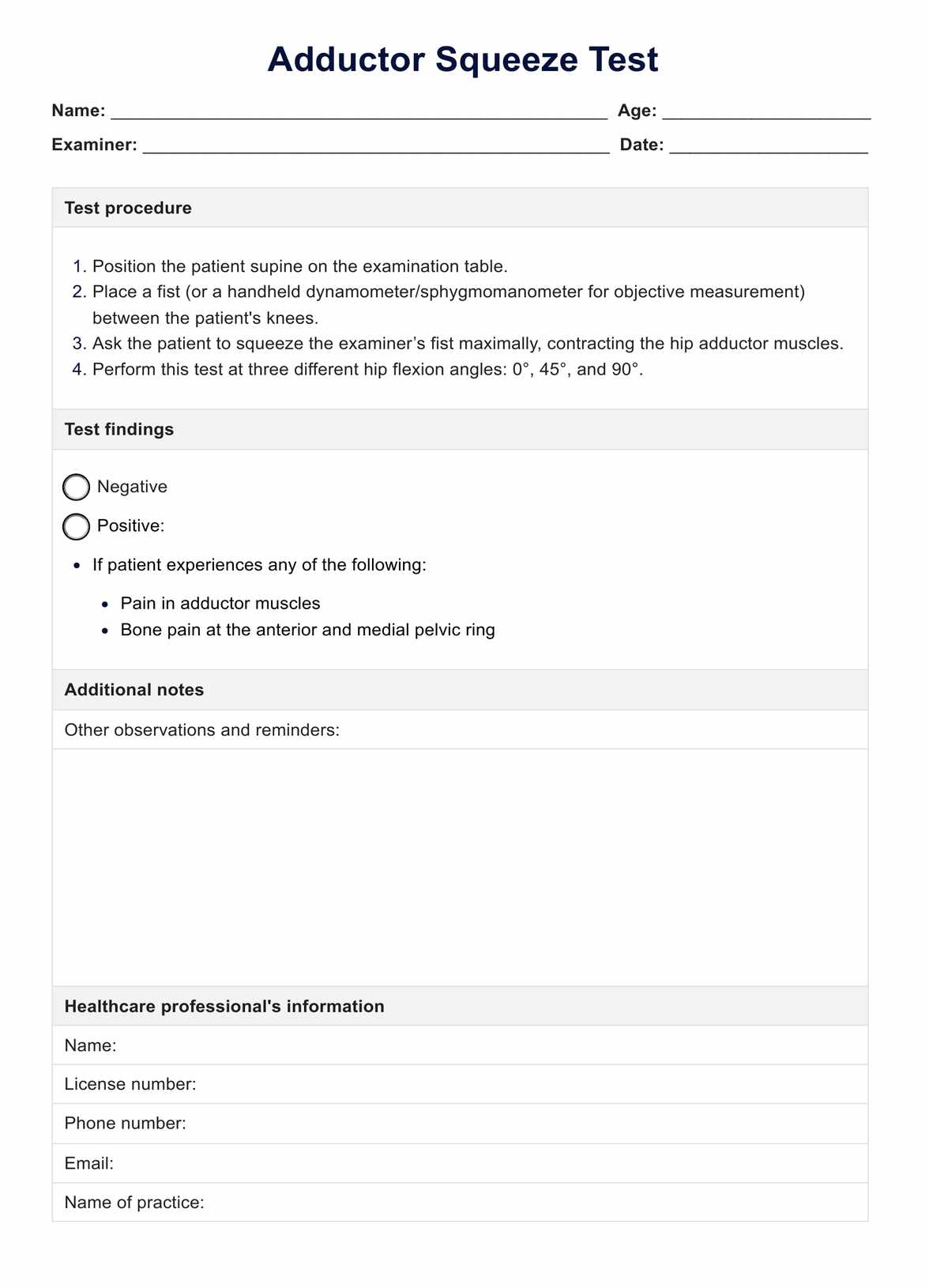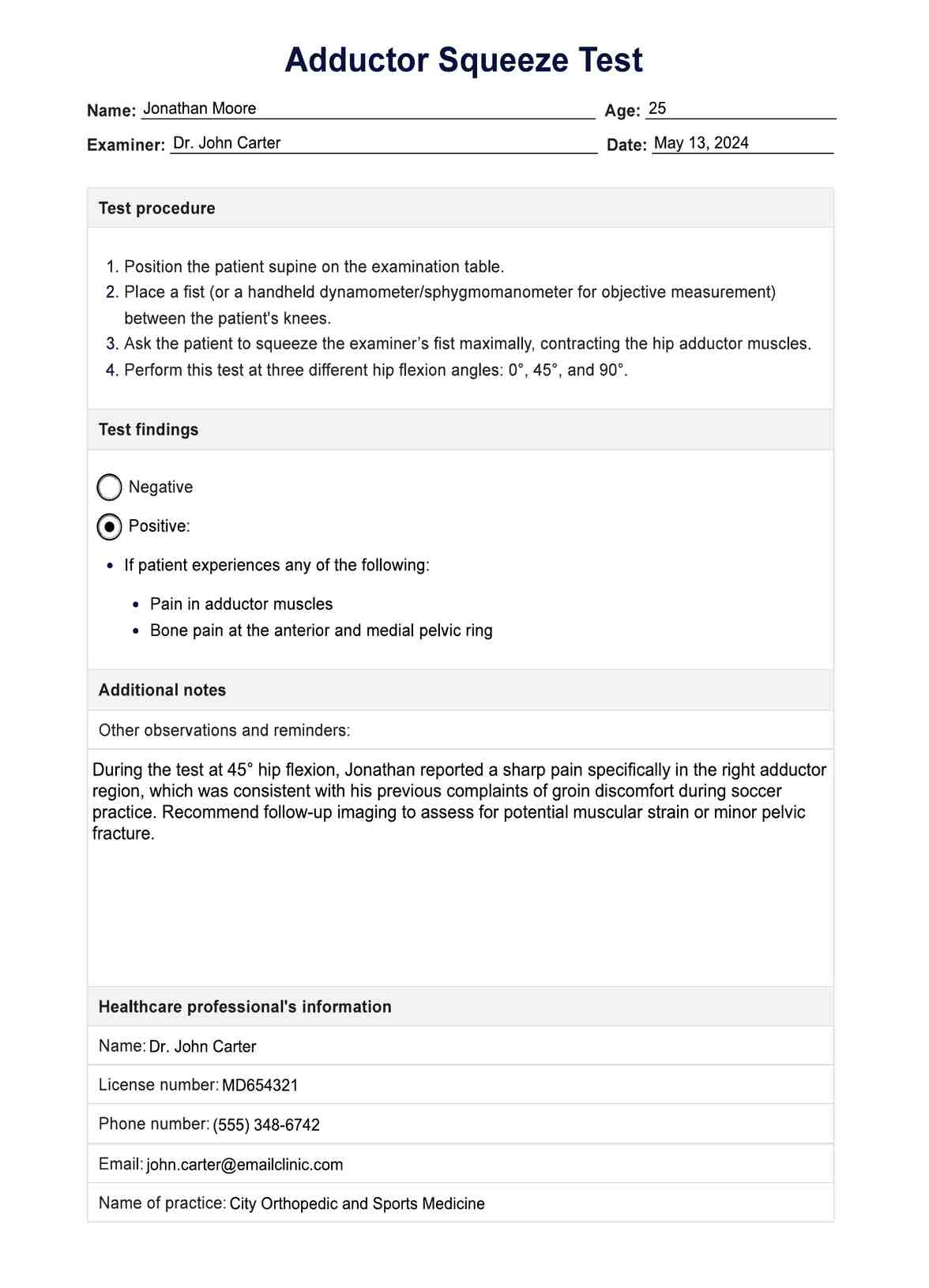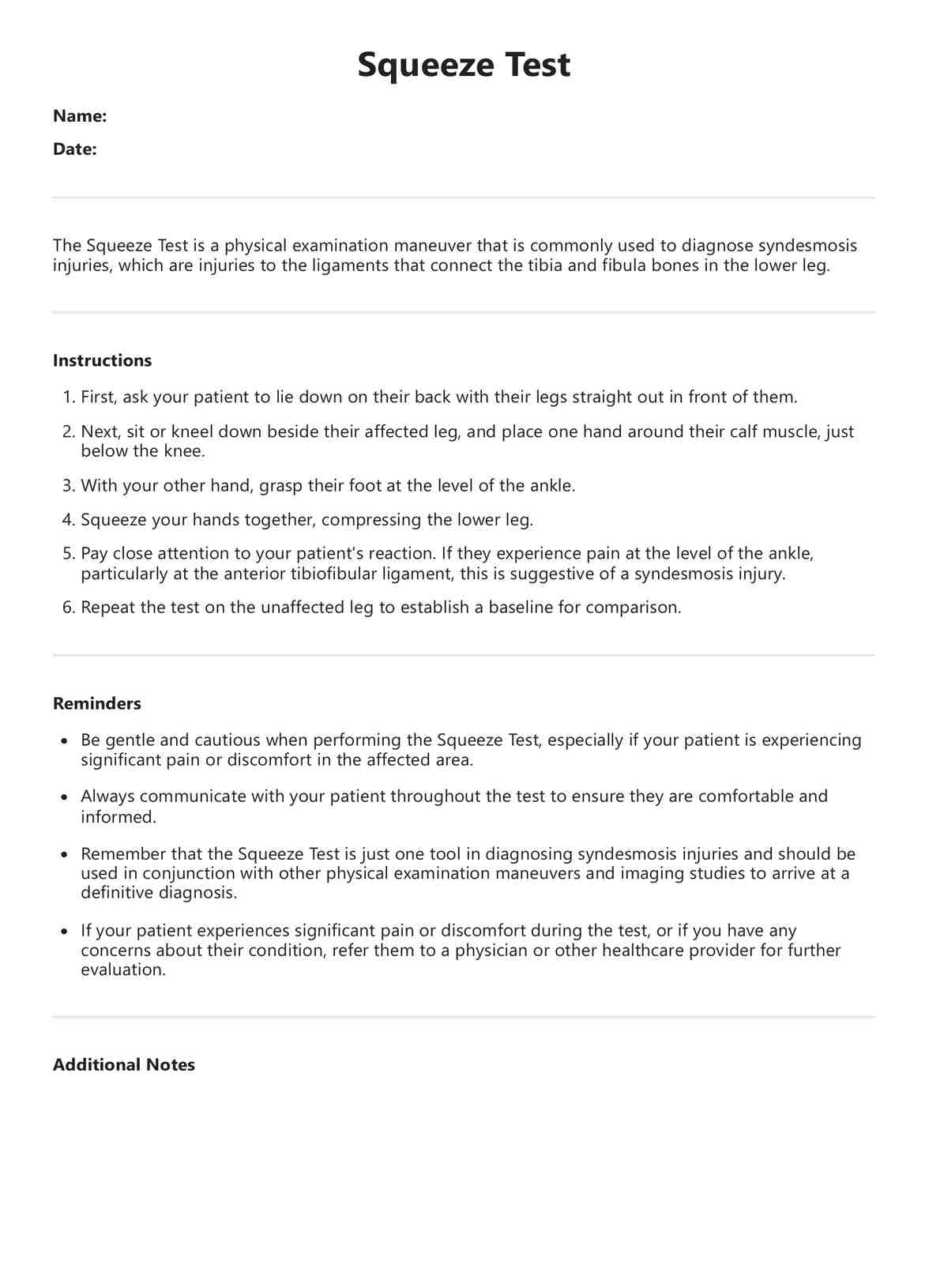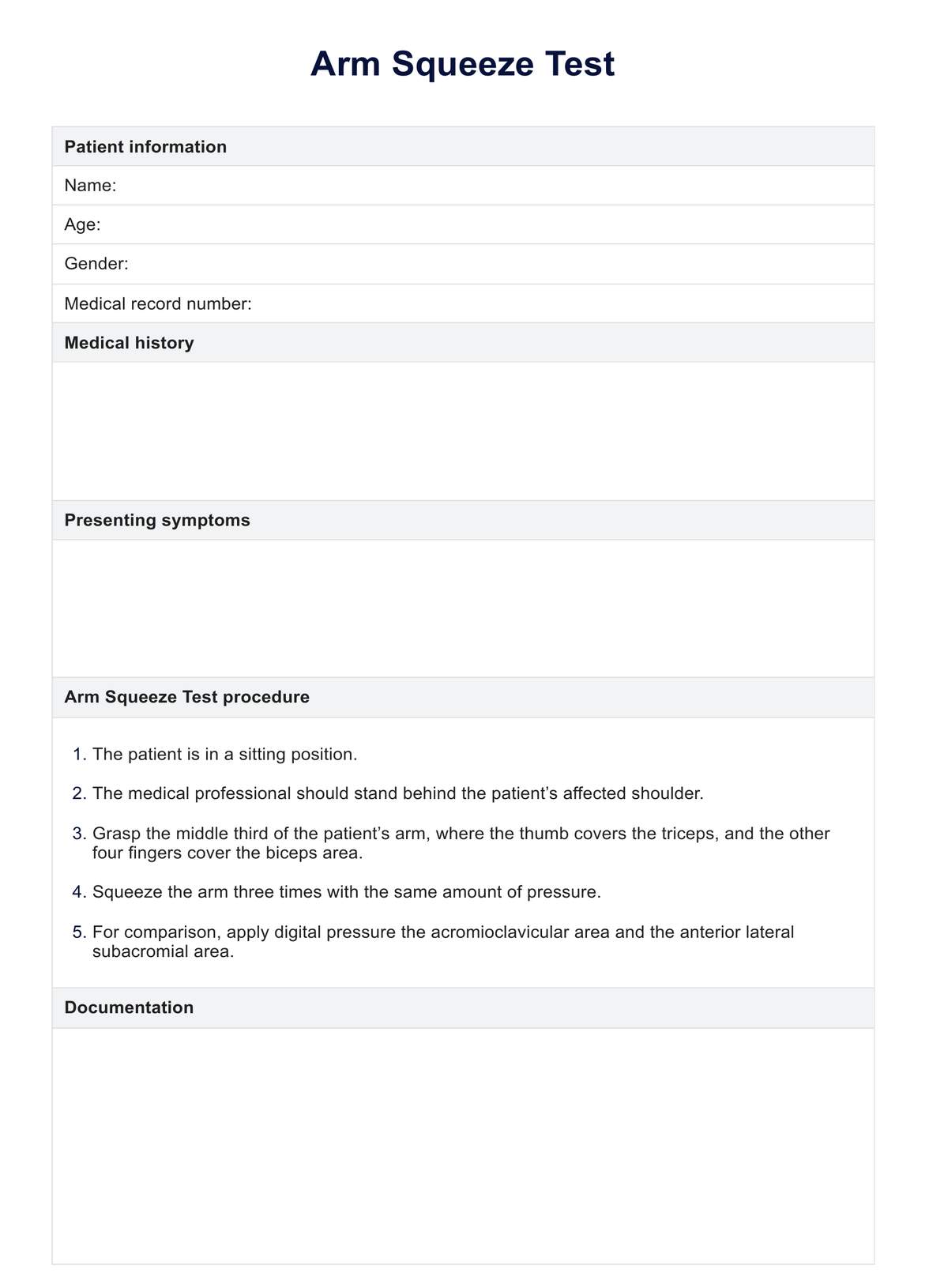Adductor Squeeze Test
Explore the Adductor Squeeze Test with our detailed guide. Assess adductor muscle strength effectively and discover the benefits of using our template.


What is adductor muscle weakness?
The adductor muscles, located in the inner thigh, are crucial for stabilizing the pelvis and controlling leg movements. These muscles are actively engaged during activities that involve drawing the legs together against resistance, such as when playing sports like soccer or when horseback riding. Their primary role is to assist in the movement of the legs toward the center line of the body, a movement known as adduction.
Adductor muscle weakness as such refers specifically to a reduction in the strength and functionality of these muscles, which can lead to difficulties in performing movements that rely on leg adduction. When the adductor muscles are weak, activities that require bringing the legs together against resistance—such as certain athletic maneuvers, climbing stairs, or even getting out of a car—become more challenging and less efficient. This weakness can also disrupt the balance and alignment of the pelvic region, leading to compensatory movements that may increase the risk of injuries elsewhere in the body, such as the lower back and knees.
Symptoms of weakened adductor muscles
Weakened adductor muscles can significantly impair mobility and stability. Here are the key symptoms:
- Difficulty in bringing the legs together
- Instability while walking or running, especially on uneven surfaces
- Groin pain or discomfort in the inner thigh
- Increased susceptibility to groin strains or injuries
Causes of adductor muscle weakness
Adductor muscle weakness can result from a variety of factors. One common cause is lack of use or undertraining, which leads to muscle atrophy. Athletes or individuals who engage in sports that require sudden changes of direction, intense side-to-side movements, and repetitive twisting are also at risk of developing weaknesses due to repetitive stress and inadequate recovery.
Additionally, groin injuries such as strains or hip issues can lead to compensatory mechanisms that weaken these muscles. Aging and certain health conditions that affect muscle strength and mobility can also contribute to the weakening of the adductor muscles.
Adductor Squeeze Test Template
Adductor Squeeze Test Example
What is the Adductor Squeeze Test?
The Adductor Squeeze Test is a clinical assessment tool designed to evaluate the strength and integrity of the adductor muscles of the thigh. Basically, the test is for eliciting adductor muscle activity, which then helps identify weaknesses or pain in these muscles. The test was developed as a simple yet effective method for quickly diagnosing issues related to the adductor muscles, particularly in athletes or individuals experiencing groin pain.
How is the Adductor Squeeze Test conducted and interpreted?
Doing the Adductor Squeeze Test involves the following steps:
- The patient lies supine on an examination table.
- The examiner places a fist or a measuring device, such as a handheld dynamometer, between the patient's knees.
- The patient is instructed to squeeze the examiner’s fist or the device maximally by contracting the adductor muscles.
- This test should be done at three different angles of hip flexion (0°, 45°, and 90°). So, raise the angle by keeping the patient's knees bent to assess the muscle strength across a range of positions.
The optimal test position is 45°, but doing it at three angles is imperative. A positive result is indicated if the patient experiences pain in the adductor muscles or the anterior and medial pelvic ring during the test. Such findings typically suggest the presence of adductor muscle strain or related issues, guiding further diagnostic and therapeutic interventions.
How to use our Adductor Squeeze Test template
Our Adductor Squeeze Test template is designed to streamline the process of conducting and recording the test in clinical settings. The template includes fields for patient information, detailed steps for the test procedure, a section for documenting the test findings, and space for additional notes. It ensures that healthcare professionals can easily and accurately capture all necessary data during the assessment.
Step 1: Access this template
To begin using our Adductor Squeeze Test template, access it through our website or physical therapy software platform. The template is available in both digital and printable formats, allowing healthcare professionals to choose the version that best fits their practice's workflow.
Step 2: Explain the template
Before performing the test, it is crucial for healthcare professionals to explain the template and the test procedure to the patient. This ensures that the patient understands what to expect during the test and how it will be conducted. Explaining the purpose of each section of the template can also help in obtaining accurate and relevant information from the patient, as they become more engaged in the process.
Step 3: Conduct the test
Using the template, the healthcare professional follows the outlined steps to conduct the test. This involves positioning the patient, applying the necessary pressure at various angles, and observing the patient's response. Each step should be carefully documented in the template to record any findings accurately.
Step 4: Record the findings
Once the test is complete, the healthcare professional should record the findings in the designated section of the template. This includes marking whether the test was positive or negative and noting any specific observations or patient feedback.
Step 5: Discuss results and next steps
After the test, discuss the results with the patient and outline any necessary next steps based on the findings. This might include further diagnostic tests, referral to a specialist, or starting a treatment plan. Documentation of this discussion should also be included in the template to ensure a comprehensive record of the patient's care journey.
Benefits of conducting this test
Conducting the Adductor Squeeze Test offers several key benefits for both healthcare professionals and their patients. Here are some of the most significant advantages:
- Early detection of issues: This test allows for the early detection of potential adductor muscle weaknesses or injuries, which is crucial for addressing issues before they worsen. Early intervention can lead to more effective treatments and quicker recovery times.
- Simple and quick: The Adductor Squeeze Test is simple to perform and does not require any special equipment, which makes it an ideal choice for a variety of clinical settings. The ease and speed of administering the test mean that it can be integrated into routine assessments without significant disruption.
- Guides treatment plans: The results from the Adductor Squeeze Test can provide valuable insights that guide the formulation of personalized treatment plans. By understanding the specific nature and extent of the weakness or pain, healthcare professionals can tailor interventions to meet the unique needs of each patient.
Overall, the Adductor Squeeze Test is very useful in both diagnosing and managing conditions related to the adductor muscles, making it a valuable tool in the toolkit of healthcare professionals, particularly those working in sports medicine and physical therapy.
Adductor muscle weakness treatment
Treating adductor muscle weakness effectively is crucial for getting back to full strength and preventing further injury, especially for athletes and active individuals. Here are several practical approaches to manage and recover from this condition:
Physical therapy
Physical therapy is often the go-to solution for adductor muscle weakness. This includes exercises such as side-lying leg lifts, standing groin stretches, and seated butterfly stretches aimed at strengthening the adductor muscles and increasing flexibility. Therapists may also use manual therapy techniques like massage and manipulation, as well as ultrasound or heat therapy to reduce pain and inflammation. A well-planned therapy program not only helps rebuild strength but also prevents future injuries.
Rest and recovery
If the weakness is due to a recent injury or if it's particularly severe, taking a break from activities that cause pain or discomfort is crucial. During this rest period, the muscles have a chance to heal. As the pain lessens, slowly getting back into movement helps the muscles regain function safely.
Medication and pain management
When pain is a major issue, over-the-counter pain relievers like ibuprofen can help manage it. It's important to consult a healthcare provider before starting any medication, especially if it's being used frequently. Applying ice or a cold compress to the affected area can also help reduce swelling and pain. This should be done for about 15-20 minutes every couple of hours during the initial days after the injury.
Surgical options
In rare cases where the muscle weakness comes from a severe tear, surgery might be necessary. This is to fix the torn muscle. After surgery, a detailed rehabilitation plan is essential to ensure a successful recovery and return to normal activities.
Preventive strategies
To prevent adductor muscle weakness, regular exercises that strengthen and stretch these muscles are key. Athletes should especially include exercises for the adductor muscles in their routine to avoid injuries. Proper warm-up before and cooling down after exercise are also vital to keep these muscles safe.
Commonly asked questions
The Adductor Squeeze Test is used to assess the strength and integrity of the adductor muscles in the thigh, helping to identify muscle weakness, pain, or groin injury that could indicate underlying issues.
Adductor tightness is often tested through specific stretches or movements that extend the leg away from the body's midline, observing for any restriction or discomfort in the inner thigh.
To test adductor squeeze with a dynamometer, place the device between the patient's knees and ask them to squeeze it while measuring the force applied, which indicates the strength of the adductor muscles.
























-template.jpg)
















































































